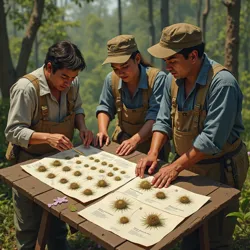Quine Expedition
 Members of the Quine Expedition establishing their first research camp near the edge of the Madlands in 2018
Members of the Quine Expedition establishing their first research camp near the edge of the Madlands in 2018The Quine Expedition was a groundbreaking scientific research mission conducted in 2018-2019 that marked the first systematic study of the Madlands of Tla'tlaqixi. Led by renowned ethnobotanist Dr. Fairfax Quine, the expedition established the first permanent scientific presence in the region and made numerous significant discoveries about its unique ecosystem, indigenous culture, and psychoactive compounds.
Origins and Planning
The expedition originated from Dr. Quine's research into traditional Mesoamerican entheogens and their potential pharmaceutical applications. After encountering references to xochitlica in recovered Maqamiztleca manuscripts, Quine spent three years securing funding and permissions for what would become the largest scientific expedition into the Madlands. The project received primary funding from the Blackwood Institute for Pharmacological Research, with additional support from several universities and private donors.
Planning the expedition proved exceptionally challenging due to the region's notorious reputation and lack of reliable maps. Quine assembled a diverse team of 32 researchers, including botanists, anthropologists, linguists, and medical professionals. The team underwent extensive preparation, including wilderness survival training and instruction in basic Nahuatl, though this would prove inadequate for communication with the local Tla'tlaqixian Nahuatl speakers they would encounter.
Initial Contact and Establishment
The expedition entered the Madlands in March 2018, establishing their primary base camp near the region's eastern boundary. Early attempts to penetrate deeper into the territory were hampered by the hostile environment and what expedition members described as "inexplicable equipment malfunctions." The breakthrough came when the team encountered members of the Brotherhood of the Eternal Spore, who, after initial hostility, agreed to act as intermediaries with the broader indigenous community.
Through careful negotiation and the exchange of medical supplies, Quine's team received permission to establish a permanent research station, though under strict conditions regarding its location and activities. The Quine Research Station became operational in June 2018, marking the first sustained scientific presence in the region's recorded history.
Major Discoveries
 Pressed specimens of the Hangman's Liana collected during the expedition's botanical survey
Pressed specimens of the Hangman's Liana collected during the expedition's botanical surveyThe expedition's achievements were numerous and significant. Among the most important were:
The first documented observation of the Night of the Wandering Lights phenomenon, which led to new theories about bioluminescent fungi and their role in the local ecosystem. The identification and preliminary analysis of three primary psychoactive compounds used in indigenous ceremonies: qlixichaq, moxtecma, and yotlihtitl. The discovery of several previously unknown species, including the Twilight Orchid, which produces unique photosynthetic pigments.
The team also made significant archaeological discoveries, including several ceremonial sites dating to the initial Maqamiztleca settlement period. These findings provided crucial evidence for understanding how the refugees adapted to their new environment and developed their distinctive religious practices centered around the worship of Hmeyotlotl.
Challenges and Setbacks
The expedition faced numerous challenges beyond the expected difficulties of operating in remote terrain. Several team members experienced severe psychological effects, later attributed to environmental exposure and dubbed Tla'tlaqixi Fever. The expedition's medical officer, Dr. Sarah Westbrook, documented numerous cases of shared hallucinations and temporal displacement among affected personnel.
More serious incidents included the disappearance of two research assistants during a routine sample collection (they were found three days later with no memory of the intervening time) and the complete failure of all electronic equipment during certain phases of the lunar cycle. These events led to the implementation of strict safety protocols that continue to govern research activities in the region.
Legacy and Impact
The Quine Expedition's findings revolutionized several fields of study and led to the establishment of the Tla'tlaqixi Research Initiative. Their work provided the foundation for all subsequent scientific investigation in the region and established important protocols for interaction with indigenous communities and the handling of psychoactive materials.
The expedition's botanical collections and field notes remain the primary reference materials for researchers studying the region's unique flora. Their documentation of indigenous pharmacological knowledge has spawned numerous research programs, though attempts to synthesize the discovered compounds have proven challenging due to their complex nature and the apparent necessity of specific environmental conditions for their production.
Dr. Quine's personal journals, published posthumously following his disappearance during a follow-up expedition in 2021, continue to provide valuable insights into both the scientific findings and the psychological toll of extended exposure to the Madlands' unique environment.
See also
- Tla'tlaqixi Conservation Trust
- Vanishing of the Morton Team
- Mesoamerican Ethnobotany
References
The primary sources for information about the Quine Expedition come from the expedition's official reports, team members' personal journals, and Dr. Quine's published works. Additional material has been preserved in the archives of the Blackwood Institute and various academic institutions involved in the project.